The Nervous System
Exercise 1
Solution A.1.
(b) neurolemma
Solution A.2.
(d) Pons – consciousness
Solution A.3.
(b) Contains both sensory and motor fibres
Solution B.1.
(a) Cerebrospinal fluid
(b) Synapse
(c) Cerebrum
(d) Hypothalamus
Solution B.2.
(a) Stimulus: Receptor:: Impulse: Effectors
(b) Cerebrum: Diencephalon:: Cerebellum: Medulla oblongata
(c) Receptor: Sensory nerve:: Motor nerve: Effector
Solution B.3.
(a) Sensory
(b) Maintaining posture and equilibrium
(c) Spinal cord
Solution C.1.
(a) Corpus Callosum – It is located
located in the forebrain. It connects two cerebral hemispheres and
transfers information from one hemisphere to other.
(b) Central canal – It is located in centre of the
spinal cord. It is in continuation with the cavities of the brain. It is
filled with cerebrospinal fluid and acts as shock proof cushion. In
addition, it also helps in exchange of materials with neurons.
Solution C.2.
(a) False
(b) False
(c) True
(d) True
Solution C.3.
(a)
| Cerebrum | Cerebellum |
| The cerebrum controls all voluntary actions. It enables us to think, reason, plan and memorize. | The cerebellum on the other hand maintains balance of the body and coordinates muscular activity. |
(b)
| Sympathetic Nervous System | Parasympathetic Nervous System |
| Sympathetic nervous system prepares the body for violent action against the abnormal condition. | Parasympathetic nervous system is concerned with re-establishing normal conditions after the violent act is over. |
(c)
| Sensory Nerve | Motor Nerve |
| Sensory nerve brings impulses from the receptors i.e. sense organs to the brain or spinal cord. |
Motor nerve carries impulse from the brain or spinal cord to effector organs such as muscles or glands. |
(d)
| Medulla Oblongata | Cerebellum |
| Medulla oblongata controls the activities of internal organs and many other involuntary actions | The cerebellum on the other hand maintains balance of the body and coordinates muscular activity. |
(e)
| Cerebrum | Spinal Cord |
| The grey matter containing cytons lies in the cortex (outer region) while the white matter containing axons lies in the medullary region (inner region). | The grey matter containing cytons lies in the medullary region i.e. inner side while the white matter containing axons lies in the cortex i.e. the outer region. |
Solution C.4.
(a) Cerebellum maintains balance of the body and coordinates muscular activity.
(b) Myelin sheath acts like an insulation and prevents mixing of impulses in the adjacent axons.
Solution C.5.
(a) Synapse: It is a gap between the
axon terminal of one neuron and the dendrites of the adjacent neuron. It
transmits nerve impulse from one neuron to another neuron.
(b) Association Neuron: It interconnects sensory and motor neurons.
(c) Medullary sheath: It provides insulation and prevents mixing of impulses in the adjacent axons.
(d) Medulla Oblongata: It controls activities of internal organs such as peristalsis, breathing and many other involuntary actions.
(e) Cerebellum: It maintains balance of the body and coordinates muscular activity.
(f) Cerebrospinal Fluid: It acts like a cushion and protects the brain from shocks.
Solution C.6.
(a) Sensory, motor and mixed nerves
(b) Somatic and autonomic nervous system
(c) Natural and conditioned reflexes
(d) Sensory, motor and association neurons
(e) Gray and white matter
Solution C.7.
(a) Stimulus — receptor — sensory neuron — central nervous system — motor neuron — effector — response
(b) Resting — depolarization — repolarization
(c) Dendrites — Dendron — perikaryon — nucleus — axon — axon endings
(d) Cerebrum — diencephalon — mid-brain — cerebellum — pons — medulla oblongata.
Solution D.1.
(a) Reflex action is an autonomic, quick and involuntary action in the body brought about by a stimulus.
(b)
| Example | Type of Reflex |
| (i) Sneezing | Simple |
| (ii) Blushing | Simple |
| (iii) Contraction of eye pupil | Simple |
| (iv) Lifting up a book | Conditioned |
| (v) Knitting without looking | Conditioned |
| (vi) Sudden application of brakes of the cycle on sighting an obstacle in front | Conditioned |
Solution D.2.
The advantages of having a nervous system are as follows:
- Keeps us informed about the outside world through sense organs.
- Enables us to remember, think and reason out.
- Controls and harmonizes all voluntary muscular activities such as running, holding, writing
- Regulates involuntary activities such as breathing, beating of the heart without our thinking about them.
Solution D.3.
The brain and the spinal cord lie in the skull and the vertebral column
respectively. They have an important role to play because all bodily
activities are controlled by them. A stimulus from any part of the body
is always carried to the brain or spinal cord for the correct response. A
response to a stimulus is also generated in the central nervous system.
Therefore, the brain and the spinal cord are called the central nervous
system.
Solution D.4.
Reflex actions are involuntary actions which occur unknowingly. Voluntary actions on the other hand are performed consciously.
Picking up an apple and eating it is an example of voluntary action
whereas withdrawal of hand on touching a hot object is an example of
reflex action.
| Reflex Action | Voluntary Action |
| Reflex actions are involuntary actions which occur unknowingly. | Voluntary actions on the other hand are performed consciously. |
| Commands originate in the spinal cord, autonomic nervous system and a few in the brain as well. | Commands originate in the brain. |
Solution D.5.
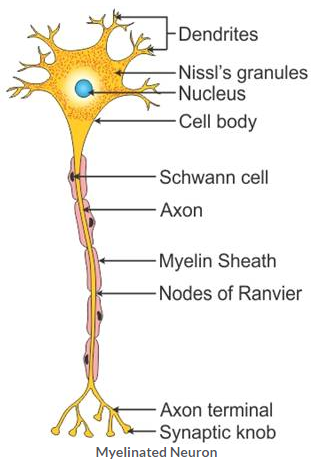
Solution D.6.
|
Organ |
Sympathetic System | Parasympathetic System |
| e.g. Lungs | Dilates bronchi and bronchioles |
Constricts bronchi and bronchioles |
|
1. Heart |
Accelerates heartbeat | Retards heartbeat |
| 2. Pupil | Dilates |
Constricts |
|
3. Salivary gland |
Inhibits the secretion of saliva causing the drying of the mouth |
Stimulates the release of saliva |
Solution E.1.
Salivation is an example of conditioned reflex that develops due to
experience or learning. Saliva starts pouring when you chew or eat food.
Therefore, this reflex will occur not just on the sight or smell of
food. The brain actually needs to remember the taste of food. Boy B
started salivating because he must have tasted that food prior unlike
boy A.
Solution E.2.
|
Situation |
Organ/body part | Change/action | Part of autonomic nervous system involved |
| 1. You have entered a dark room | Eye | Pupil dilates |
Sympathetic |
| 2. Your body is consuming lot of glucose while running a race | Liver | Glycogen is converted into glucose in liver | Sympathetic |
| 3. You are chewing a tasty food | Salivary gland | Salivation increases |
Parasympathetic |
| 4. You are running a race | Adrenal gland | Release of adrenaline and noradrenaline increases | Sympathetic |
| 5. You are retiring to bed for sleep | Heart | Heart rate slows down |
Parasympathetic |
| 6. You are shivering in intense cold | Body hairs | Hair raised |
Sympathetic |
Solution E.3.
Fill in the following information in the diagram.
- Central Nervous System
- Autonomic
- 12
- spinal
- 31
- dilates
- constricts
- liver
Exercise 2
Solution A.1.
(b) Cornea
Solution A.2.
(b) Cochlea
Solution A.3.
(c) Eustachian tube, tympanum and utriculus
Solution A.4.
(a) Retina
Solution B.1.
(a) Rhodopsin
(b) Eustachian tube
(c) Hammer
(d) Dura mater
(e) Eustachian tube
(f) Cornea
(g) Auditory nerves
(h) Rods and cones
(i) Hypermetropia
Solution B.2.
(a) Cones: Iodopsin:: rods: rhodopsin
(b) Sound: ear drum:: dynamic balance: semi-circular canals
Solution B.3.
| Column I | Column II |
| i. The blind spot | (h) no sensory cells |
| ii. The yellow spot | (g) centre of the retina |
| iii. Ciliary muscle | (b) Shape of the lens |
| iv. Iris | (e) free of rod cells, (a) colour of the eye |
| v. Meninges | (c) Protective covering of the brain |
Solution C.1.
(a) Myopia results when the eye ball is lengthened from front to back or the lens is too curved.
Hyperopia results from either too shortening of the eyeball from front to back or when the lens is too flat.
(b) Rods are sensitive to dim light but do not respond to colour.
cones are sensitive to bright light and are responsible for colour vision.
(c) cochlea is responsible for hearing; it can perceive the senses of hearing.
Semicircular canals are responsible for perceiving the senses to maintain the body balance.
(d) Rod cells contain rhodopsin whereas the cone cells contain iodopsin.
(e) Dynamic balance is when the body is in motion whereas static balance is positional balance with respect to gravity.
Solution C.2.
(a) False
Correct statement: Deafness is caused due to rupturing of the eardrum.
(b) False
Correct statement: Semicircular canals are concerned with dynamic balance.
Solution C.3.
(a) Fovea centralis is located at the
back of the eye almost at the centre of the eyeball. It is the region of
the brightest vision and also of the colour vision.
(b) Organ of corti is located in the inner ear. It contains sensory cells which process hearing.
Solution C.4.
(a) True
(b) False/ Ciliary muscles regulate the size of the lens.
(c) True
(d) False/The auditory nerve responsible for sound as well as for the body balance.
(e) True
(f) False/ flavour is a combination of taste and smell.
(g) False/ short-sightedness is myopia and hyperopia is long-sightedness.
(h) True
Solution C.5.
(a) Auditory canal, tympanum, ear ossicles, oval window, cochlea
(b) Conjunctiva, cornea, lens, retina, optic nerve
Solution C.6.
(a) Organ of Corti and hearing
(b) Olfactory nerve and smell
(c) Retina and vision
(d) Taste bud and taste
Solution C.7.
(a) Lacrimal gland is a tear gland
located at the upper sideward portion of the eye orbit. Its secreation
lubricates the surface of the eye, washes aways the dust particles and
kills germs
(b) Yellow spot is the region of brightest vision and contains maximum sensory cells whereas a blind spot contains no sensory cells and this is the point of no vision.
(c) Presbyopia is an age-old eye defect. In this condition, the lens loses flexibility resulting in far-sightedness.
Cataract is also very common in old people, the cornea becomes opaque and the vision is cut down even to blindness.
(d) The process of focusing the eye at different distances is called the power of accommodation.
(e) The image formed on the retina is inverted and real.
Solution C.8.
An optical illusion is the life-like continuous movement on the screen.
Television is an example of optical illusion, where the scanning beam of
a picture frame of the TV camera moves so rapidly on the viewing screen
of the TV set that our eyes cannot keep pace with it.
Solution C.9.
(a) Oval window is located in the middle ear. It helps in setting the fluid in the cochlear canals into vibration.
(b) Cochlea is located in the inner ear. It helps in transmitting impulses to the brain via the auditory nerve.
(c) Semicircular canals are located in the inner ear. These help in maintaining the dynamic equilibrium of the body.
(d) Utriculus is located in the inner ear. It joins the
semi-circular canals to cochlea. It also helps in maintaining static
balance of the body.
Solution C.10.
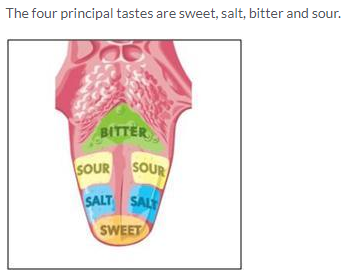
Solution C.11.
|
Structure |
Function |
| Yellow Spot |
Region of the brightest vision |
|
Auditory nerve |
Transfers impulse from inner ear to brain |
| Ciliary muscle |
Helps to change the focal length of the eye lens |
|
Spinal cord |
Conducts impulses |
| Oval window |
Sets fluid in cochlear canal into vibration |
|
Semicircular canals |
Dynamic equilibrium |
Solution D.1.
While reading a book, the lens is more convex or rounded due to
contraction of ciliary muscles because the book is usually read from a
short distance. When we raise our head and look at a distant object, the
ciliary muscles relax to build the tension on the suspensory ligament
so that they can stretch the lens. This change in the curvature of the
lens makes us focus on distant object.
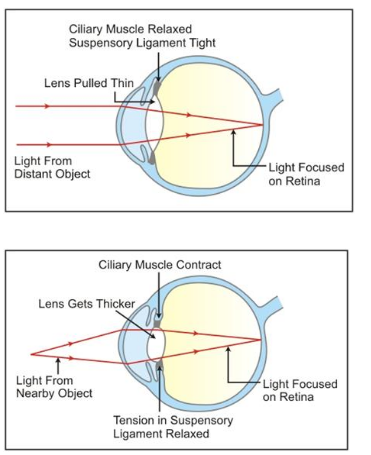
Solution D.2.
The brain sees the vivid picture of the dream through the eyes. Our eyes
have actually never seen the vivid picture. This is an example of
optical illusion. The area of dream is controlled by the cerebrum of the
central nervous system. So sometime we can remember the vivid picture
seen in the dream.
Solution D.3.
If we look at a bright object and then close our eyes, the sensation of
light persists for a short period. This is known as persistence image or
the after image. It lasts for one-tenth of a second. Therefore by
closing the eyes and gently pressing them with your palms, you see some
specs of brilliant light.
Solution D.4.
Adaptation is the ability to adjust
vision in bright and dark areas. When we enter a dark room from bright
light, the rhodopsin pigment broken down in bright light is regenerated.
It dilates the pupil and allows more light to enter the eyes. This is
called dark adaptation. On the other hand, if we enter
bright area from a dark room, the rhodopsin pigment is bleached. This
constricts the pupil and reduces the light entering the eyes. This is
called ‘light adaptation‘
Accommodation is the process of focusing the eye at different distances. This is mainly brought about by a change in the curvature of the lens. When the ciliary muscles contract, the lens becomes thicker and we are able to focus a nearby object. On the other hand when the ciliary muscles relax, the lens remains stretched i.e. the normal condition and we are able to focus on distant object.
Solution D.5.
Our eyes are designed to focus at a great variety of distances. To focus
constantly at a short distance can make the lens focusing muscles
fatigued. Therefore, we do not enjoy watching a movie from a very short
distance from the screen in cinema hall.
Solution D.6.
|
Defect of vision |
Cause | Corrective measure |
| Myopia | Lengthening of eye ball from front to back or the lens is too curved. |
Using suitable concave lens |
|
Hyperopia |
Shortening of eye ball from front to back or the lens is too flat. | Using suitable convex lens |
| Astigmatism | Uneven curvature of the cornea |
Using suitable cylindrical lenses |
|
Presbyopia |
Loss of flexibility of lens | Using suitable convex lens |
| Cataract | Lens turning opaque |
Surgery or use of convex lens or implantation of plastic lens. |
|
Colour blindness |
Genetic defect | No control measure |
| Squint | Formation of cross-eye |
Surgery and suitable exercise |
Solution D.7.
The three ear ossicles are: Malleus (hammer), Incus (anvil) and Stapes (stirr up).
The last ear ossicle, stapes, vibrates and transmits the vibration to the oval window.
The role of other two ear ossicles is to magnify the vibration of stapes as a result of their lever like action.
Solution D.8.
The process of focusing the eye at different distances is called the
power of accommodation. The ciliary muscles are responsible for the
power of accommodation.
Solution E.1.
a. The ability of the eye to focus sharply on things which are near to
the eye as well as far off is known as the power of accommodation.
b. Shape of the eye:
Near vision – flattened
Distant – rounded or more convex
c. Ciliary muscles and suspensory ligament
d. In the dark: Cells – rod cells, Pigment – rhodopsin
In the light: Cells – cone cells, Pigment – iodopsin
Solution E.2.
a. The middle ear or membranous labyrinth has two structures inside it, the cochlea and the semi-circular canals.
b. Malleus, incus and stapes
c. Static balance – Utriculus and sacculus (inner ear)
Hearing – Internal ear
Dynamic balance – Semi-circular canals (inner ear)
d. Collectively they are termed as ossicles.
Solution E.3.
(a) Cornea is comparable to the lens cover of the camera.
The iris and pupil act like the aperture of a camera.
(b) The cornea is the eye’s main focusing element. It takes widely
diverging rays of light and bends them through the pupil; the rays are
further converged by the lens.
Solution E.4.
(a) Myopia
(b) The two possible reasons for myopia are either the eye ball is lengthened from front to back or the lens is too curved.
(c) 1 – vitreous humour, 2 – blind spot, 3-lens, 4-pupil
(d) Concave lens
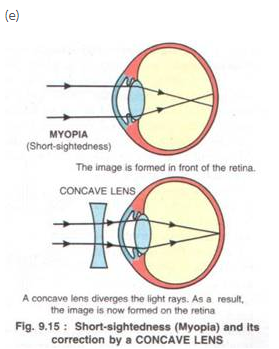
Solution E.5.
(i) Ear
(ii) m – malleus, i – incus and s – stapes respectively. These are collectively called as ear ossicles.
(iii) Cochlea. The vibrating movements in the hair of the sense cells of
cochlea transmit the impulse for hearing to the brain via auditory
nerve.
(iv) Tympanic membrane. It vibrates and then sets the ear ossicles into vibration in the process of hearing.
Solution E.6.
(i) Ear ossicles
(ii) A – Cochlea, B – Semicircular canals, C – Ear ossicles
(iii) Cochlea helps in transmitting impulses to the brain via the
auditory nerve. Semicircular canals help in maintaining dynamic
equilibrium of the body.
(iv) Organ of Corti
Solution E.7.
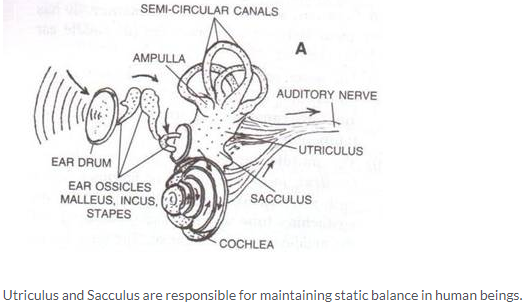
(a) Myopia
(b) A-Normal eye, B-Myopia
(c) Looking glasses with the concave lens are required here.
Comments
Post a Comment